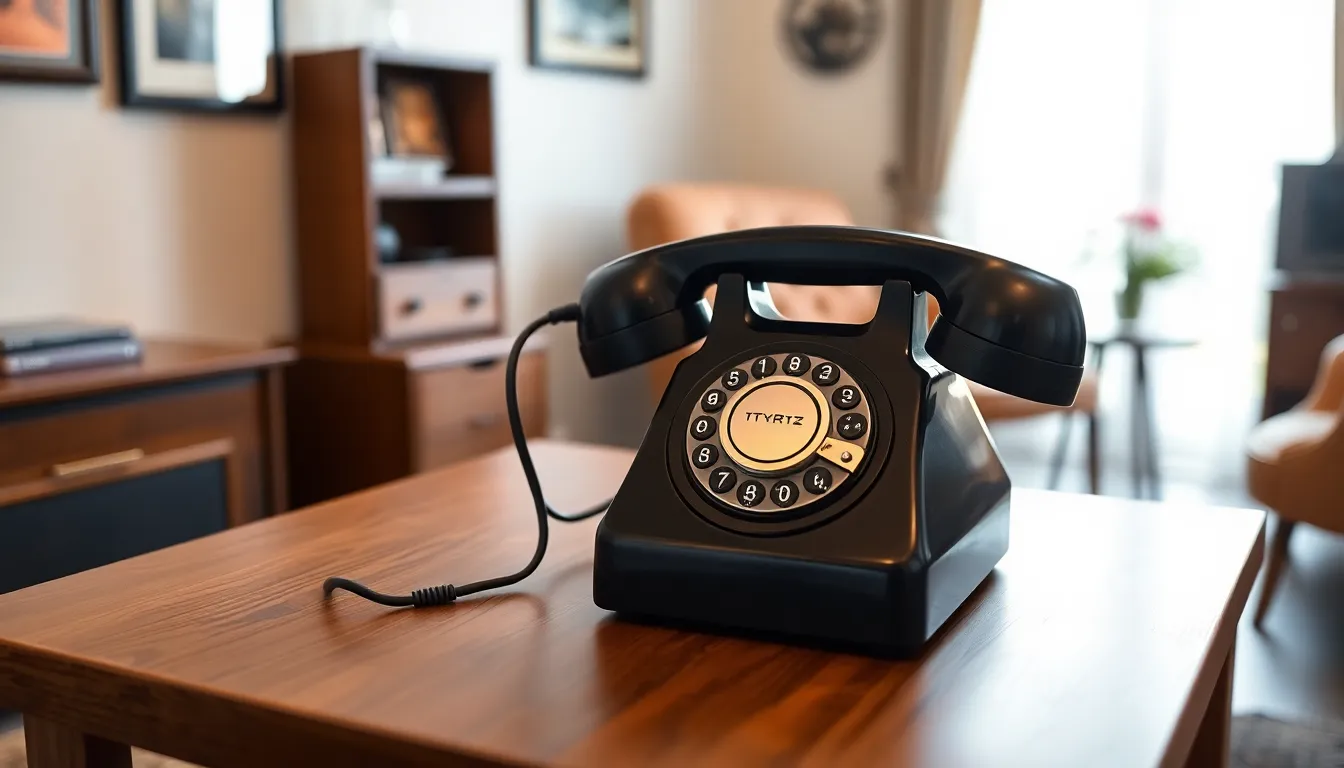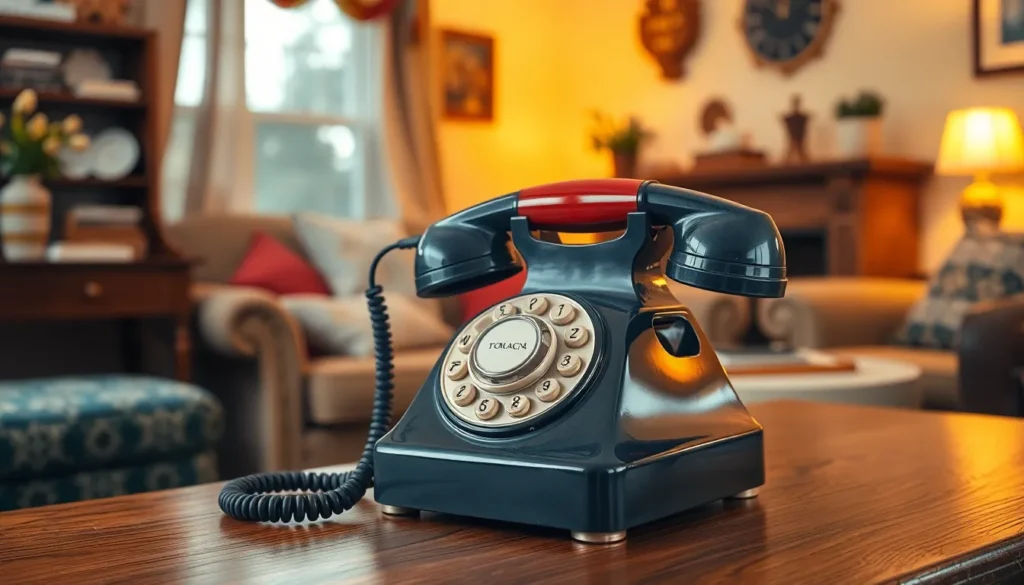In a world where smartphones reign supreme and texting has replaced talking, one might wonder if rotary phones still have a place in our hearts—or our homes. Picture this: a time when dialing meant a delightful dance of fingers around a circular dial, each number a tiny adventure. But do these nostalgic relics still work, or are they just fancy paperweights collecting dust?
Table of Contents
ToggleThe History of Rotary Phones
Rotary phones emerged as iconic communication devices in the 20th century. Their design and functionality shaped early telephone technology.
Invention and Popularity
The invention of the rotary phone took place in the late 1800s. It revolutionized communication, allowing users to dial directly instead of relying on operators. By the 1920s, rotary phones gained immense popularity in households across the United States. Different manufacturers, like Western Electric and AT&T, produced various models tailored for consumer preferences. The unique mechanical sound of the dial added to the charm, making rotary phones not just functional but also a part of home decor. By the mid-century, nearly 90% of telephone users utilized rotary telephones.
Decline of Use
Rapid advancements in technology led to the decline of rotary phones. The introduction of push-button telephones in the 1960s offered faster dialing options, capturing users’ attention. Many households transitioned to these newer models, favoring convenience over nostalgia. By the 1980s, rotary phones became increasingly rare in everyday use. Despite their decline, many vintage rotary phones remained in style as collectors’ items, symbolizing a bygone era. Today, while rotary phones may not see daily use, their historical significance endures through shipments and collector communities.
How Rotary Phones Function

Rotary phones operate through a simple yet effective mechanism that has stood the test of time. They utilize a mechanical dialing system that transmits dialed numbers via pulses.
Mechanical Dialing Mechanism
The dialing mechanism relies on a rotating dial. Users turn the dial to the desired number, and as they release it, the dial returns to its original position. This action creates pulses corresponding to the number dialed. Each number generates a different number of pulses. For example, dialing a “1” produces one pulse, while dialing “9” creates nine pulses. The receiving telephone exchanges interpret these pulses and connect the call. This straightforward design accounts for rotary phones’ durability and ease of use.
Telephone Line Connectivity
Rotary phones connect to telephone lines through traditional copper wiring. These lines carry both the electrical signals and pulses generated by the dial. A complete circuit is essential for the phone to function. When users pick up the receiver, it completes the circuit, enabling them to dial out. The phone communicates with the central office, signaling the desired number based on pulse patterns. Although modern systems favor digital signals, rotary phones can still work on analog lines. This compatibility with older telephone infrastructure demonstrates their lasting functionality even in today’s tech-savvy world.
Current Technological Landscape
Today’s telecommunications landscape has evolved significantly, but rotary phones still possess unique attributes that enable functionality. Newer standards focus on digital signals and high-speed connections, which contrasts sharply with the rotary phone’s original analog design.
Modern Telecommunication Standards
Modern telecommunication standards primarily rely on digital systems and Voice over Internet Protocol (VoIP) technologies. These advancements facilitate rapid and efficient communication. While rotary phones weren’t designed for today’s infrastructure, they can function on compatible lines without digital features. Technological shifts toward fiber optics and wireless networks do not directly include rotary phones. Despite this, rotary models retain nostalgic charm and serve decorative purposes in some households.
Compatibility with Landlines
Compatibility with landlines remains a highlight for rotary phones. Many traditional landlines still utilize analog systems, enabling these rotary devices to connect without issues. Users often find the simplicity of rotary dials appealing for basic calling needs. Electrical signals transmitted through copper wiring support their functionality even in the digital age. For those residing in areas where landlines still exist, rotary phones serve as a reliable means of communication.
Do Rotary Phones Still Work?
Rotary phones can function in today’s world, particularly on analog lines. Exploring their operation highlights both their lasting utility and the challenges they present.
Testing Vintage Models
Testing vintage rotary phones requires specific conditions. Consistent connectivity to analog landlines is essential for proper functionality. Users often verify their performance through simple dialing tests, ensuring they can make and receive calls. Collectors may find success with models from the 1950s to the 1970s, as these typically use standard technology. Many shops and online platforms offer adapters to connect rotary phones to modern systems, enhancing their usability. Individuals seeking nostalgia can enjoy genuine communication experiences through their vintage devices.
Limitations and Challenges
Limitations surface when using rotary phones in a digital world. Compatibility with VoIP services presents challenges, as these systems often require digital dialing methods. Users may discover that certain features, such as speed dialing, don’t exist on rotary models. Additionally, difficulties arise in emergency situations where fast dialing is crucial. With many telecom providers phasing out analog services, finding support for these traditional devices becomes increasingly tough. Users still relying on rotary phones may encounter inconveniences, given the evolving infrastructure of communication technologies.
Rotary phones remain a fascinating blend of nostalgia and functionality in today’s fast-paced digital world. While their practicality may be limited due to modern telecommunications advancements, they still hold a unique charm for collectors and enthusiasts. For those with access to analog lines, these vintage devices can still connect calls effectively, preserving a piece of history.
As technology continues to evolve, rotary phones may become less common, but their enduring appeal as collectibles ensures they’ll always have a place in the hearts of many. Whether as a conversation starter or a reminder of simpler times, rotary phones continue to captivate those who appreciate their timeless design and historical significance.





